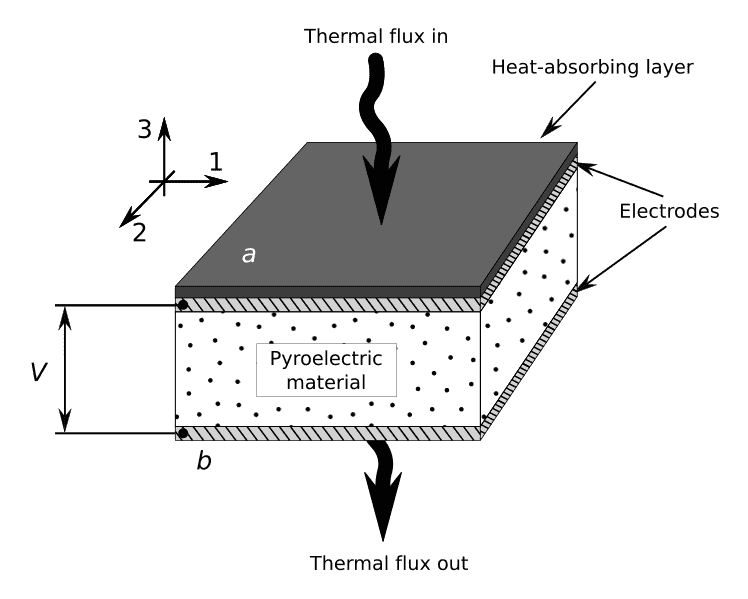5 Properties of Pyroelectric Materials Explained
Properties of pyroelectric materials are; thermo-electric coupling, non-centrosymmetry, spontaneous polarization, ferroelectricity, and piezoelectricity.
This article discusses the properties of pyroelectric materials, as follows;
1). Thermo-Electric Coupling (as one of the Properties of Pyroelectric Materials)
With regards to pyroelectric materials, thermo-electric coupling is the proportional relationship between thermal energy and electricity, in these materials.
It can also be described as thermal-to-electric conversion, and is one of the key attributes of pyroelectric materials, as well as the primary basis of the pyroelectric effect.
It must be noted that there is another class of materials that exhibit thermo-electric coupling. This is the thermoelectric group, and can be differentiated from pyroelectric materials based on the fact that thermoelectricity depends on temperature changes with area [6], while pyroelectricity depends on temperature changes with time.
The temporal thermo-electric coupling in pyroelectric materials implies that they are capable of generating electricity when heated and cooled periodically.
Also, the amount of electricity generated in a pyroelectric material at any given range and rate of temperature change depends on the pyroelectric coefficient of the material. For those with strong pyroelectric properties, low-grade heating can produce significant electric potential [2].

2). Non-Centrosymmetry
Non-centrosymmetry is one of the typical properties of pyroelectric materials, whose detection in any material suggests that it may also have pyroelectric attributes [5].
It describes an internal crystalline (chemical) structure where there is not singular axis that defines the center of symmetry of a given crystal.
Non-centrosymmetry is indicative of varied electronic dipolar configurations at various segments of a material's chemical structure, which is one of the factors that influences spontaneous polarization in pyroelectric materials.
For the same reason, non-centrosymmetric materials are also usually piezoelectric, meaning that they can generate electricity of varying amounts, when subjected to mechanical stress [1].
3). Spontaneous Polarization (as one of the Properties of Pyroelectric Materials)
Spontaneous polarization is polarization of electrons and ions in a material as a result of only internal causes, without need for any external influence such as an electric field [3].
The main factor that is responsible for spontaneous polarization in any material is a lack of internal, chemo-structural symmetry, which creates a state of dis-equilibrium that allows the ionic components of the material to be mobilized by internal stimuli.
In pyroelectric materials, this internal stimuli is time-based temperature change [4].
It is spontaneous polarization that differentiates pyroelectric materials from conventional electric conductors, which are polarized in the presence of an external electric field.
4). Ferroelectricity
Ferroelectricity is another important property of pyroelectric materials.
All pyroelectric materials are not ferroelectric; rather, ferroelectric materials are a group of pyroelectric materials whose spontaneous polarization only occurs when they are cooled below a specific temperature called the Curie temperature.
The difference between pyroelectric and ferroelectric materials is simply that pyroelectric materials exhibit spontaneous polarization over a broader range of temperatures than ferroelectric materials, so that it is correct to refer to the latter as a subset of the former [7].
All ferroelectric materials are both pyroelectric and piezoelectric because of their ability to change polar axial directions in response to internal stimuli.
The detection of ferroelectric behavior in pyroelectric materials is often a crucial aspect of their study.
5). Piezoelectricity (as one of the Properties of Pyroelectric Materials)
Piezoelectricity describes the electric potential that is generated in a material as a result of the effect of mechanical stress across its surface area.
All pyroelectric materials are piezoelectric, and this is as a result of spontaneous polarization and non-centrosymmetry in these materials.
The nature and intensity of piezoelectric behavior in pyroelectric materials may differ with factors like specific chemical structure, magnitude of mechanical stress, and temperature conditions.
Conclusion
Properties of pyroelectric materials are;
1. Thermo-electric Coupling
2. Non-Centrosymmetry
3. Spontaneous Polarization
4. Ferroelectricity
5. Piezoelectricity
References
1). Dishon, S.; Ushakov, A.; Nuraeva, A.; Ehre, D.; Lahav, M.; Shur, V.; Kholkin, A.; Lubomirsky, I. (2020). "Surface Piezoelectricity and Pyroelectricity in Centrosymmetric Materials: A Case of α-Glycine." Materials (Basel). 2020 Oct 19;13(20):4663. Available at: https://doi.org/10.3390/ma13204663. (Accessed 1 March 2023).
2). Ikura, M. (2002). "Conversion of Low-Grade Heat to Electricity Using Pyroelectric Copolymer." Ferroelectrics 267(1):403-408. Available at: https://doi.org/10.1080/00150190211013. (Accessed 1 March 2023).
3). Khan, I. M.; Upadhyay, T. C. (2021). "General Introduction to Ferroelectrics." Multifunctional Ferroelectric Materials. Available at: https://doi.org/10.5772/intechopen.97720. (Accessed 1 March 2023).
4). Małuszyńska, H.; Scherf, C.; Czarnecki, P.; Cousson, A. (2003). "The neutron diffraction study of pyridinium periodate at 352, 300 and 100 K." Journal of Physics Condensed Matter 15(33):5663. Available at: https://doi.org/10.1088/0953-8984/15/33/301. (Accessed 1 March 2023).
5). Smith, G. W.; Daniel, M. F.; Barton, J. W.; Ratcliffe, N. (1985). "Pyroelectric activity in non-centrosymmetric Langmuir-Blodgett multilayer films." Thin Solid Films, Volume 132, Issues 1–4, October 1985, Pages 125-134. Available at: https://www.sciencedirect.com/science/article/abs/pii/004060908590464X. (Accessed 1 March 2023).
6). Thakre, A.; Kumar, A.; Song, H. C.; Jeong, D. Y.; Ryu, J. (2019). "Pyroelectric Energy Conversion and Its Applications-Flexible Energy Harvesters and Sensors." Sensors (Basel). 2019 May 10;19(9):2170. Available at: https://doi.org/10.3390/s19092170. (Accessed 1 March 2023).
7). Whatmore, R. W. (1991). "Piezoelectric and Pyroelectric Materials and Their Applications." In: Miller, L.S., Mullin, J.B. (eds) Electronic Materials. Springer, Boston, MA. Available at: https://doi.org/10.1007/978-1-4615-3818-9_19. (Accessed 1 March 2023).



